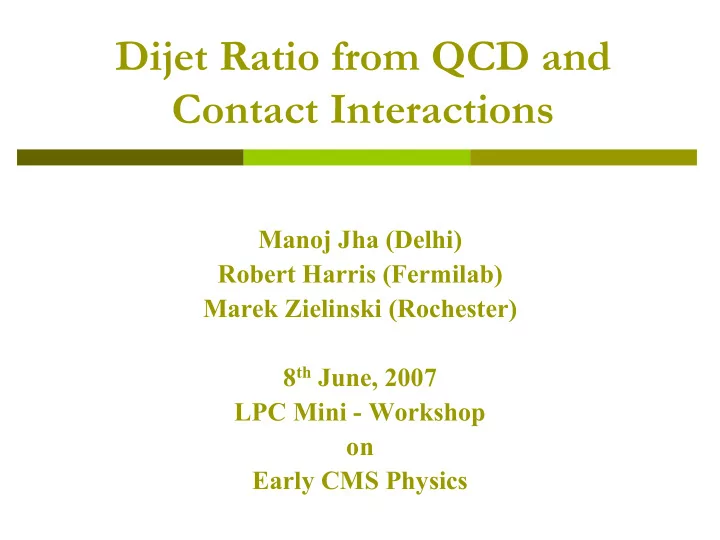

Dijet Ratio from QCD and Contact Interactions Manoj Jha (Delhi) Robert Harris (Fermilab) Marek Zielinski (Rochester) 8 th June, 2007 LPC Mini - Workshop on Early CMS Physics
Overview � Motivation � Data Sample and Analysis � QCD Background � Differential Cross Sections � Dijet Ratio � Contact Interaction Signal � Dijet Ratio � Early in CMS � Later in CMS � Conclusion 2
Search for Contact Interactions Quark Compositeness New Interactions � New physics at a scale Λ q q M ~ Λ above the observed dijet M ~ Λ mass is effectively modelled as a contact q q interaction. Dijet Mass << Λ � Quark compositeness. Quark Contact Interaction � New interactions from q q massive particles exchanged Λ among partons. q q � Search for contact interactions QCD using dijet ratio. � Simple measure of dijet angular distribution. t - channel 3
Data Sample and Analysis � Data Sample � CMSSW_1_2_0 QCD dijet sample � Combine Sample using weights � Simulated in different P T hat bins � No Pileup � CaloJets reconstructed using Midpoint Cone 0.5 (Scheme B CaloTowers) � MCJet corrections applied to Calo Jets � Generated, Calo and Corrected Calo Jets being considered � We also study partons from hard collision. � Analysis � Looking at d σ /dM for two leading jets residing in | η | cut � Dijet Ratio = N ( | η | < 0.5 )/ N ( 0.5 < | η | < 1.0 ) 4
d σ /dM for QCD � Cross Section � Higher for 0.5 < | η | < 0.1 � Due to t-channel exchange of gluons among point like quarks 5 and peaked heavily in the forward direction.
Dijet Ratio for QCD � Ratio is roughly flat at 0.6 . � Similar to ratio from ORCA in PTDR II. 6
Ratio with Multiple Jet Type � Ratio from Corrected CaloJets and GenJets are similar at 0.6 . � Ratio from CaloJets is higher due to response variations versus η . � Jet response in | η | < 0.5 is slightly greater than 0.5 < | η | < 1.0 � Expected 1 – 2% change in relative jet response in two | η | 7 regions can cause the difference that we see here ( from PTDR II).
Dijet Ratio for QCD � Ratio is roughly flat at 0.6 . � No difference between partons and genjets at low mass and around 5% at high mass. 8
Contact Interaction Signal � Canonical model among left handed composite quarks given by Eichten, Lane and Peskin. � All quarks participating in contact interaction. � Signals generated in multiple P T hat bins, like QCD. � Generated jets reconstructed using Midpoint cone 0.5 � Didn’t run full CMS detector simulation � Good agreement between corrected calo jets and generated gen jets. 9
d σ /dM for Contact Interaction Signal � Contact interaction rate increases at higher mass. � Smaller the compositeness scale, the larger its effect. 10
d σ /dM from QCD & Contact Signal QCD QCD + Contact I nteraction � Signal is contributing at high mass and at low | η |. 11
Dijet Ratio with MC Statistics � Dijet ratio for signal increases with increase in dijet mass. � Smaller compositeness scales have larger effect on dijet ratio at higher dijet mass. 12 � QCD background is relatively flat versus dijet mass.
Dijet Ratio with MC Statistics � Until we get to very high scales & high dijet masses the partons are almost identical to the genJets for the ratio. 13
Dijet Ratio Early in CMS � Statistical error bars on QCD dijet ratio are expected error bars � Plots have been updated to use Poisson statistics � For 10 pb -1, we should be sensitive to ~3 TeV scale (new, not in PTDR II) � For 100 pb-1, we should be sensitive to 5 TeV scale (as in PTDR II) � Last Tevatron limit on compositeness scale is 2.7 TeV at 95% confidence level for integrated luminosity of 100 pb -1 . 14
Dijet Ratio Later in CMS � With 1–10 fb -1 , we will be sensitive to scales of 10-15 TeV (Same as in PTDR II). � Smaller the compositeness scale, the larger its effect. 15
Conclusions & Next Steps � We have done the first study of the dijet ratio with CMSSW. � Results are similar to Physics TDR II. � With only 10 pb -1 of data, CMS is sensitive to a contact interaction just beyond the current Tevatron limit. � Next Steps � Optimize η cuts for best sensitivity to contact interactions � Repeat PTDR II estimates of 5 σ sensitivity to contact interactions. 16
Recommend
More recommend